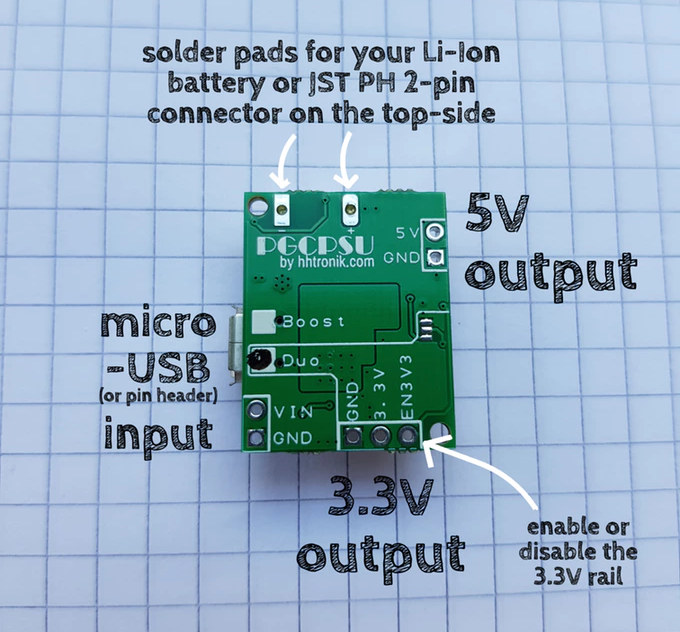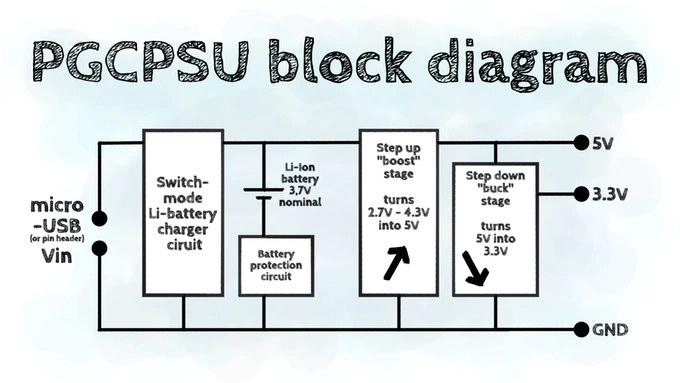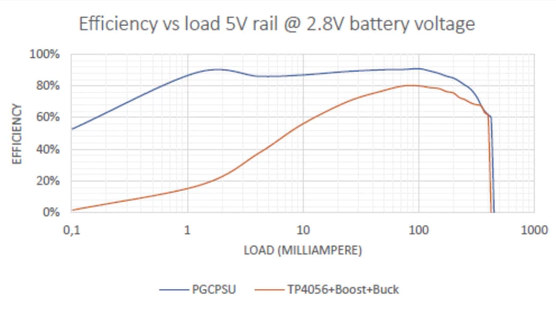Last year we wrote about a two dollars USB 18650 battery shield that allows you to easily power your board over USB using a 18650 LiPo battery. But if you need some more flexibility, and extra features such as reverse polarity protection, PGCPSU, which stands for “Pretty Good Cheap Power Supply Unit”, may be worth looking into.
 PGCPSU key features & specifications:
PGCPSU key features & specifications:
- Power Input – micro USB input or pin header for charging (4.7V to 6V max.)
- Power Output
- 5V rail providing at least 350mA, and up to 650mA
- 3.3V rail providing at least 400mA, and up to 800mA
- Safety
- Integrated battery protection including reverse polarity protection
- Over-discharge, short circuit/over-current protection
- Power Efficiency
- High efficiency even at low load, important for long battery life
- Low quiescent current (49uA for the 5V rail + 57uA for the 3.3V rail)
- Enable/disable pin for the 3.3V rail with selectable default state solder jumper
- Charging – Quick charging at up to 1.9A (fully charges a 2,600mAh cell in about 2 hours)
- Dimensions – 25x20mm
 Staudt Technologies highlights the efficiency of their module by comparing it to a similar design based on off-the-shelf parts such as TP4056 battery charger, or DW01A protection IC, and PGCPSU had a much better efficiency, especially at low loads thanks to the low quiescent current.
Staudt Technologies highlights the efficiency of their module by comparing it to a similar design based on off-the-shelf parts such as TP4056 battery charger, or DW01A protection IC, and PGCPSU had a much better efficiency, especially at low loads thanks to the low quiescent current.
They also reported battery life with a 2,600 mAh battery that is included in some of the kits for different scenarios:
- 3.5 days for Arduino Blinky sketch.
- 17 hours for a Raspberry PI Zero W posting its uptime to a REST API via WiFi
- Over 4 months and still running for an ESP8266 based soil moisture and temperature sensor that is posting a measurement every 10 minutes; same result for an ESP8266 based WiFi / PIR motion sensor
The module can also be used as an uninterruptible power supply.
 PGCPSU has now launched on Kickstarter with a lowly 1,250 Euros funding target. Rewards start at 7 Euros for a PGCPSU DUO (5V/3.3V) module and a PGCPSU Boost (5V only) module, but once all early bird rewards are gone price for PGCPSU Duo is offered for 11 Euros, or you may consider a starter kit with a DUO module plus a 2,600 mAh 18650 LiPo battery. Shipping adds a further 7 Euros, and backers can expect their rewards between May and August 2019 depending on the selected perk.
PGCPSU has now launched on Kickstarter with a lowly 1,250 Euros funding target. Rewards start at 7 Euros for a PGCPSU DUO (5V/3.3V) module and a PGCPSU Boost (5V only) module, but once all early bird rewards are gone price for PGCPSU Duo is offered for 11 Euros, or you may consider a starter kit with a DUO module plus a 2,600 mAh 18650 LiPo battery. Shipping adds a further 7 Euros, and backers can expect their rewards between May and August 2019 depending on the selected perk.

Jean-Luc started CNX Software in 2010 as a part-time endeavor, before quitting his job as a software engineering manager, and starting to write daily news, and reviews full time later in 2011.
Support CNX Software! Donate via cryptocurrencies, become a Patron on Patreon, or purchase goods on Amazon or Aliexpress




